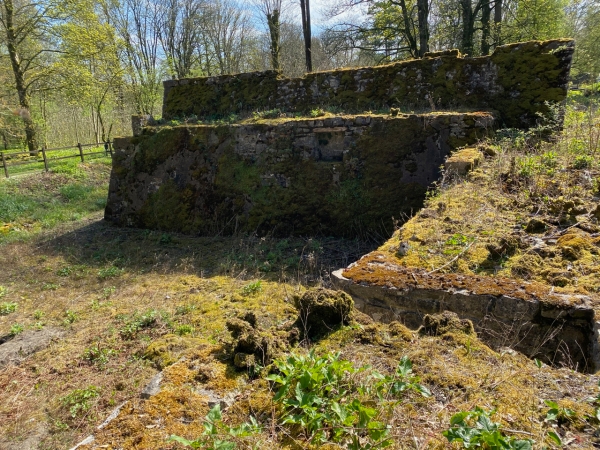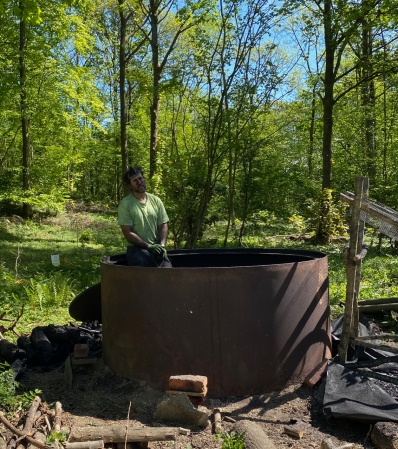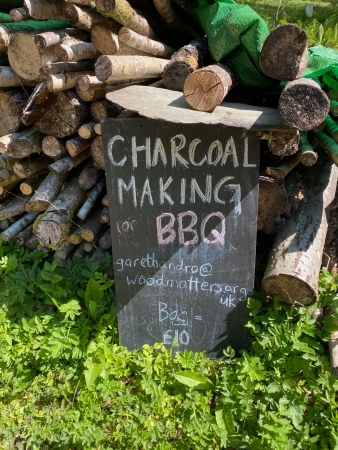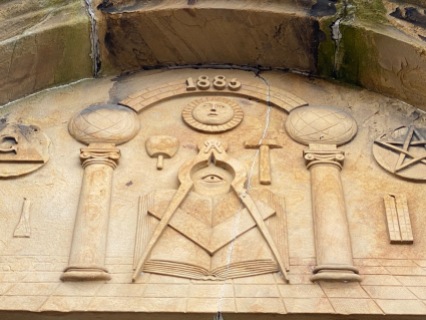
I’m writing this on Sunday. The unexpected gale-force wind is battering the house. Temperatures have dropped thirteen degrees in the middle of the night – I know, because I woke up at four, fought wakefulness for half an hour (it may have been the bright moon), then gave in and let the collie out for a wee, to find I was too cold to photograph the startling moon without dashing back in to don a coat…
This in a spring so warm you could have gone out in beach shorts for most of the days and nights of the previous two weeks. Not the norm for Cumbria!

The beautiful spring moon is unrelated to the rest of this post, but why waste it!. There weren’t too many people out in their gardens at 04:30 pointing a camera at the night sky.

Our C-19 ‘lockdown’ has been made more tolerable by the weather and the proximity of some lovely walks. Living on the edge of the English Lake District, we are fortunate, indeed, to have so many of them. We try to use the car as little as possible, though it’s the only way to do weekly food shopping, as we live in a tiny village four miles from the nearest supermarket.

To keep car usage to a minimum, we regularly use four local walks. One of these winds up from the river Kent’s valley into Sizergh forest. It is part of a well-managed estate, which includes the ruins of the old gunpowder works. I am currently researching the history in order to complete a series of posts on the subject.
Industrial history can be far more complex than you envisaged…

The walk through the forest climbs up from the river before levelling off at a crossroads of paths. One of the way-markers (without which many walkers would be lost) is a large charcoal-kiln. I photographed it in April, just as the forest was ‘greening’.

On Saturday, we got to the crossroads to find a masked man in a green T-shirt working the kiln. I asked if I could take some photos, and he kindly stopped to chat to us, raising his mask. His name is Gareth (see the photo of his board), and he has the licence to carry out forest maintenance on behalf of the owners – The National Trust – as well as running his own charcoal production business and other forest-related activities.

Gareth reassured us that the process of charcoal production was a simple matter, but, in the manner of skills handed down through the generations, what he described seemed anything but simple.
He was standing in the middle of his kiln, blackened with the messy work; the mask now pulled up over his forehead in what looked like a rhino’s horn. For all the visual drama, he turned out to be a wonderfully friendly man.
Later, I realised that his demeanour and openness had a lot to do with his life in the open forest, and his closeness to its nature. Clearly, he loved his work, and its many faces.
Charcoal is prized because it burns at high temperatures without making smoke; hence its popularity with domestic summer barbecues. It is the ‘residue’ of a method of burning (typically) small logs of wood – ideally hardwood, such as oak or cherry. The production method is a slow pyrolysis: the heating of wood and, possibly, other organic materials, without allowing oxygen to enter the chemical reaction. The whole process is known as charcoal burning. The finished charcoal consists largely of carbon. It is a very pure substance, produced by an ancient recipe.
Seeing charcoal made so close to the old gunpowder works was ironic, because charcoal is an important ingredient of gunpowder – produced in large quantities a century ago in the nearby works. The Sizergh forest is no stranger to the production of charcoal…

Gareth paused his work and described the process of making charcoal for us. It takes four days to complete and begins where he stood, in the centre of the kiln. The relatively thin logs – recycled from his coppicing work – are laid out radially from the centre. They are set and ventilated so the fire in the lowest part of the kiln begins with a great intensity, sacrificing the lower level of wood but infusing the steel vessel with intense heat, but only burning the lower levels of the wood.
The kiln is ‘over-stuffed’ to begin the process, but, in the secondary stage of the burning, the heat and the weight of the lid seals the cylinder, itself, allowing only enough oxygen to enter to ensure the charcoal effect, rather than burning the wood to ash. All the timing is controlled by the initial stacking of the wood within the kiln, which, to me, sounded like a very skilled process, indeed.

Four days later, the charcoal has cooled and Gareth once again steps into his kiln to extract the charcoal by hand, dropping it into a metal and plastic ramp from which it is loaded into large carriers for subsequent domestic bagging in his workshop, near the river.

His busy time is usually the summer months, when people have barbecues. But the warm spring weather is enabling him to bring forward more charcoal production. During the winter, demand is minimal, so he supplements his income with forestry work, and also runs outdoor courses in making furniture from ‘green’ wood.

He took about twenty minutes from his busy schedule to explain things to us. We thanked him and moved on through the forest, only to meet him, later, loading his truck, when we returned from our walk to Low Sizergh Barn.
I have no commercial connection with Gareth. The above was our first meeting. I am keen to support these native crafts and small industries of our local woodlands. Gareth and Ro’s website is a mine of information.
If the above links don’t work, paste this into your browser and help support our native forest crafts: http://www.garethandro@woodmatters.org.uk

©Stephen Tanham 2020
Stephen Tanham is a Director of the Silent Eye School of Consciousness, a not-for-profit teaching school of modern mysticism that helps people find a personal path to a deeper place within their internal and external lives.
The Silent Eye provides home-based, practical courses which are low-cost and personally supervised. The course materials and corresponding supervision are provided month by month without further commitment.
Steve’s personal blog, Sun in Gemini, is at stevetanham.wordpress.com.




























Thank you. Steve. More knowledge for my old noddle…Keep well.
LikeLiked by 1 person
Thank you, Joy. Glad you enjoyed it. I’d always wondered about the charcoal process, myself. Nice to learn new things, as you said. You stay well, too!
LikeLike
Thank you for this lovely post, Steve. It was good to meet Gareth, Trevor the tractor and see your Moon shot. I too love the natural forest crafts and it was interesting to read how charcoal is produced. Xx
LikeLiked by 1 person
Reblogged this on Sue Vincent's Daily Echo.
LikeLiked by 1 person
Thank you, Sue x
LikeLiked by 1 person
How interesting. I saw a programme on TV once about a man who made his own charcoal. I think he built a straw bale house too and got permission to live in the forest due to his work. It’s great to see these ancient skills in use.
Your location looks idyllic. Thank you for sharing the wonderful photos.
LikeLiked by 1 person
Glad you liked it. I think I saw the programme – was he in the New Forest, and eventually got permission to build a wooden house and live there for his lifetime, but the house had to be returned to the forest on his passing?
LikeLiked by 1 person
Yes that rings a bell. I think it was on Grand Designs or something like that. He was a really interesting character. Totally dedicated to living a simple off-grid life.
LikeLiked by 1 person
Yes, it was Grand Designs. Well remembered! I used to love that programme. I was so moved that they had granted him the right to build and live there for his lifetime only
LikeLiked by 1 person
Reblogged this on Campbells World.
LikeLiked by 1 person
This reminded me of the charcoal burners who appear in one of Arthur Ransome’s books. Pigeon Post, I think it is. Set in or near your area, too. It’s good to know this skill lives on.
LikeLiked by 1 person
Thank you, Audrey. I had always wondered about charcoal, as it was a major component (15%) of gunpowder, which was the only claim to fame our village has! Fortunately, most of it was for peaceful purposes. It’s great to known these skills are still alive 😎
LikeLiked by 1 person
Fascinating, Steve. I didn’t know this process was still in use, but I am glad to know it is. I read all about this in a book I read last year. It was very interesting, all about two cotton mill apprentices and their lives. Thanks for sharing this, Steve.
LikeLiked by 1 person
Thank you, Robbie. I forgot to add in the post that we stumbled across Gareth’s work only because the bright moon got me up so early and all the usual events of our ‘lockdown’ days were brought forward! My grandparents and my mother worked in the mills of Bolton, so their stories might well have been similar to the book you read.
LikeLiked by 1 person
It sounds like a terrible life, Steve. People were so abused physically.
LikeLiked by 1 person
Yes, hard and short. But it made them treasure each good thing… and waste nothing!
LikeLike
That was really interesting Steve what an interesting man to find in the wood.
LikeLiked by 1 person
Thank you, Willow. A happy coincidence. Normally, we would have been in the woods later, but I woke very early! ❤️
LikeLike
Everything happens for a reason. 💜
LikeLiked by 1 person
Quite so… 😊
LikeLike
💜💜
LikeLike
Pingback: Charcoal, focus and heart-stones – Sun in Gemini